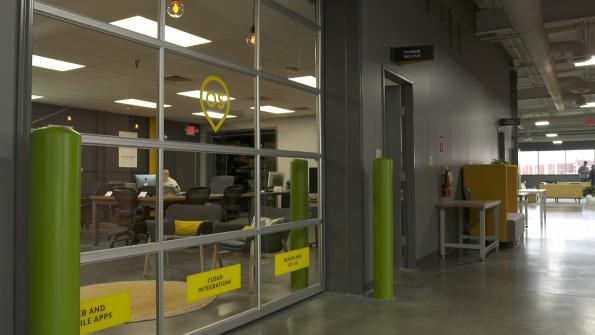Why cities in the Rust Belt should invest in IoT
Despite “Rust Belt” infamy, many cities across Indiana, Michigan, Ohio and Pennsylvania are still portraits of industry. Like many of our Midwestern neighbors, Indiana’s key industries are manufacturing, agriculture and distribution – and have been for many years. These sectors have given generations of Midwesterners the opportunity to improve their economic position and provide a better quality of life for their families. Throughout these generations, Midwesterners have developed deep subject matter expertise in these industry sectors. Yet all three of these industries are in the direct collision path of Internet of Things (IoT) disruption. Today, in the midst of what experts are calling “The Second Industrial Revolution,” cities across the Rust Belt have an opportunity to support the next generation of innovators.
The IoT is a somewhat simple concept with complex applications. Imagine most of the common, everyday machines on which we depend being interconnected in a way that eliminates repetitive actions, provides predictive analytics, and allows for total integration of once-independent systems. For example, Case is testing the first driverless tractors. Greenwood, Ind., a fellow Indianapolis suburb, recently lost a $259 million investment from FedEx due to automation and streamlining. Advancements in technology surrounding the IoT have made all of this possible. According to Statista, by 2025, the IoT retail market will exceed $11 billion. The projected growth is staggering, considering that, in 2018, the market will barely brush $4 billion. Within this IoT transformation, there exists both opportunity and calamity. Those governmental entities that adapt will experience the substantial opportunities that exist, while those that choose to ignore this revolution will suffer for it.
I recently read about a company’s $90 million investment in a manufacturing facility in a smaller Indiana community. Thirty years ago, a $90 million manufacturing facility might bring 1,000 jobs. Today, the facility is expected to create 90 to 100 jobs. Other manufacturing announcements publicize hundreds of millions of dollars in investment while job numbers actually shrink. The same is true in agriculture. The productivity of farming equipment has increased exponentially in the last two decades. Now, imagine automating that equipment, and picture the impact that would have on employment opportunities. In short, it will not serve our residents well if Indiana is filled with empty fields, automated warehouses and robotic manufacturing plants. This scenario continues to play out in cities across the Rust Belt.
What is a local government in the Rust Belt to do?
Firstly, we should not abandon the cornerstones of our economies. When manufacturers modernize their products and processes to account for IoT, we must demonstrate that we have the companies, people and wherewithal to provide those services. While the rest of the country has looked to the coasts for innovation in the past, the Rust Belt has an opportunity to lead this new economy, much like they did during the industrial revolution. The industries are here. The customers are here. Who better to automate the plant floor, the farm field, and distribution center then the people built those very industries. Now is the time to grow the economy by not only further developing existing industries, but also nurturing new industry sectors that can produce higher-paying wages and jobs. Our public policy must reflect this initiative, and our higher education institutions must adapt. Finally, our leaders in manufacturing, agriculture and distribution must make meaningful investments in the Internet of Things economy.
In March, Fishers, Ind., celebrated the grand opening of the Indiana IoT Lab – the first city-funded IoT incubator of its kind. Our hope is to lay a foundation for grassroots IoT innovation within state lines to support our leaders in manufacturing, agriculture and distribution. The Indiana IoT Lab, housed in a 24,562-square-foot former manufacturing facility, was only made possible through the collaboration between the public and private sectors. For other cities wishing to kickstart the IoT economy within city limits, the mantra “if you build it, they will come” simply does not apply. Starting a project of this scale first requires a deep understanding of the talent and companies around you. It’s not about the physical building, but more the skills and expertise you bring to the building. Before a city embarks on a similar IoT initiative, you must first measure your local technology ecosystem. Without our local private sector companies, the plant would continue to sit empty.
Too often in politics and public policy, our choices are binary. If you are in support of “this,” then you must oppose “that.” I don’t believe this to be true about this new economy. I celebrate the successes of our leaders in manufacturing, agriculture and distribution. My hope is that cities across the Rust Belt can seize the opportunity to create an economy that provides economic opportunity and upward mobility for generations to come.
p.p1 {margin: 0.0px 0.0px 15.0px 0.0px; line-height: 22.2px; font: 15.0px Georgia; color: #323333}
p.p2 {margin: 0.0px 0.0px 15.0px 0.0px; line-height: 22.2px; font: 12.0px Georgia; color: #323333}
span.s1 {font-kerning: none}
span.s2 {font: 12.0px Georgia; text-decoration: underline ; font-kerning: none; color: #0e5f8b}
span.s3 {font: 15.0px Georgia; font-kerning: none}
_____________
To get connected and stay up-to-date with similar content from American City & County:
Like us on Facebook
Follow us on Twitter
Watch us on YouTube




















